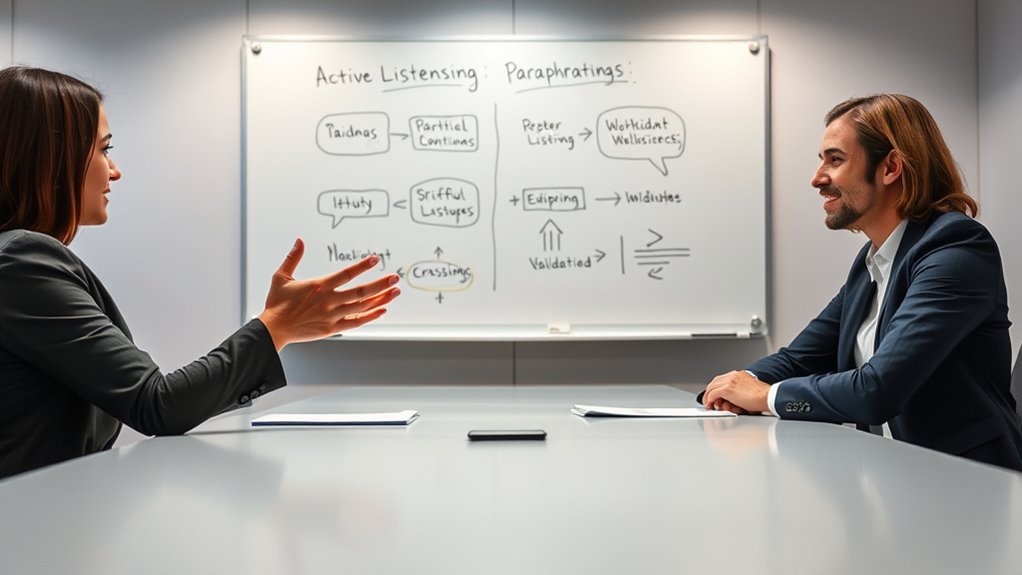To validate a speaker using paraphrasing skills, focus on actively listening and accurately reflecting their main ideas in your own words. Pay attention to emotional and cultural cues, making sure your restatement maintains tone and nuance. Confirm understanding with brief summaries and verbal affirmations. Be mindful of common pitfalls like misinterpreting tone or oversimplifying. Practicing these techniques helps build trust and ensures clear, respectful communication—if you keep practicing, you’ll uncover even more effective ways to connect authentically.
Key Takeaways
- Use active listening to accurately grasp and restate the speaker’s main ideas, demonstrating understanding.
- Summarize key points in your own words to confirm comprehension and show validation.
- Incorporate emotional and cultural cues into paraphrasing to respect the speaker’s intent and nuance.
- Ask clarifying questions or use verbal affirmations like “So you’re saying…” to reinforce engagement.
- Maintain tone consistency and emotional nuance to ensure your paraphrase aligns with the speaker’s original message.
Understanding the Power of Paraphrasing

Have you ever wondered why paraphrasing is such a valuable skill? It’s because it helps you grasp and convey the true meaning behind someone’s words, respecting cultural nuances. When you paraphrase, you adjust the tone to match the context, showing empathy and understanding. This skill allows you to avoid misunderstandings caused by differences in language or background. By accurately capturing the speaker’s intent, you demonstrate active listening and build trust. Paraphrasing isn’t just about repeating words; it’s about interpreting meaning while considering subtle cultural cues. This makes your communication more effective and respectful. Additionally, understanding the importance of content accuracy ensures that your paraphrases are not only empathetic but also precise, aligning with the factual information presented. When you master this, you not only validate the speaker but also foster clearer, more meaningful interactions.
Techniques for Effective Restatement

To restate effectively, focus on clarifying the main ideas so your audience clearly understands your message. Use your own words to express the original meaning, making it more relatable and easier to grasp. Always confirm your understanding to make sure you’re conveying the right information accurately.
Clarify Key Ideas
How can you guarantee your restatement clearly captures the original idea? By paying close attention to non verbal cues and practicing active listening, you can better understand the speaker’s intent. Focus on their tone, gestures, and facial expressions to grasp the emphasis and emotional nuances behind their words. When you paraphrase, reflect these key ideas accurately, ensuring you aren’t adding assumptions or missing critical details. Clarifying key ideas involves confirming your understanding by summarizing the main points precisely. Use your observations of non verbal cues to identify any gaps or ambiguities, then ask clarifying questions if needed. This approach helps you restate ideas confidently and accurately, demonstrating that you truly comprehend what’s being communicated. Incorporating essential oils for effective communication can also enhance your focus and listening skills, supporting better understanding during conversations. Additionally, understanding AI’s role in education can provide valuable context for interpreting complex information and improving your paraphrasing accuracy. Paying attention to the resonance of non verbal cues can further improve your ability to capture the essence of the speaker’s message. Recognizing spiritual symbolism in angel numbers can also deepen your comprehension of nuanced messages and underlying meanings in conversations.
Use Your Own Words
Are you looking for ways to make your restatements more clear and genuine? Using your own words is key to active listening and empathetic communication. When you rephrase, focus on capturing the speaker’s main ideas without copying their exact language. This shows you understand and care about their message. To do this effectively:
- Summarize the core message in simple terms.
- Avoid parroting words; instead, interpret meaning.
- Use phrases that reflect empathy and understanding.
- Confirm that your restatement aligns with what’s been said.
- Incorporate personal growth principles to deepen your engagement and demonstrate genuine comprehension.
- Recognize narcissistic traits that may influence how messages are conveyed or received, helping you tailor your responses more effectively.
- Leveraging sound healing science can also provide insights into emotional states, enabling more mindful and resonant communication.
- Being aware of individual responses to divorce can help you adjust your communication approach to support emotional well-being.
- Developing an understanding of different divorce processes in various states enhances your ability to respond appropriately and empathetically.
Confirm Understanding Clearly
Ever wonder how to make sure you truly understand someone’s message? The key is active listening combined with verbal affirmation. As you listen, focus fully on the speaker, avoiding interruptions. Once they finish, restate their main points in your own words to confirm comprehension. Use clear, concise paraphrasing to reflect their message accurately. Don’t forget to incorporate verbal affirmation, like “So what you’re saying is…” or “If I understand correctly, you mean…”. This not only shows you’re engaged but also encourages the speaker to clarify if needed. Effective restatement ensures both of you are on the same page. Incorporating listening skills can further improve your ability to interpret messages accurately. By actively listening and confirming understanding clearly, you create a trust-building environment for open, honest communication. Practicing paraphrasing techniques can further enhance your ability to communicate effectively and build trust, especially when combined with protective styling methods like crochet styles for locs to foster a respectful dialogue environment. Additionally, understanding the best vacuums for dust removal in 2024 can help you maintain a cleaner, healthier home environment, which supports overall well-being.
Recognizing Emotional Cues in Conversations

Recognizing emotional cues in conversations is essential for understanding what others truly feel beyond their words. Your ability to pick up on subtle signals enhances your emotional intelligence and improves communication. Pay attention to tone detection, as vocal inflections often reveal feelings behind the message. Body language, facial expressions, and gestures also provide valuable insights. Here are four key ways to recognize emotional cues: 1. Listen for changes in tone or pitch 2. Observe facial expressions and eye contact 3. Notice gestures and body posture 4. Detect inconsistencies between words and behavior Additionally, understanding the context and environment, such as the local reviews and seasonal influences seen in places like Laguna Beach, can help interpret emotional cues more accurately. Recognizing vibrational energy and its effects can also provide insights into broader social and emotional trends shaping communication. Moreover, being aware of how skin condition affects facial expressions can improve your interpretation of emotional states during interactions. Incorporating knowledge of relationship dynamics can further refine your ability to read subtle emotional signals in various interpersonal contexts.
Common Mistakes to Avoid When Paraphrasing

While picking up on emotional cues sharpens your understanding of others, paraphrasing their words accurately can be more challenging than it seems. One common mistake is losing tone consistency, which can confuse your audience and weaken your message. If your paraphrase doesn’t match the speaker’s original intent or emotional nuance, you risk miscommunication. Additionally, failing to engage your audience with clear, relatable language can cause them to tune out or misunderstand your point. Be careful not to oversimplify or distort what was said, as this damages trust and diminishes the validation process. To avoid these pitfalls, stay attentive to the speaker’s tone and keep your paraphrasing precise and aligned with their emotional context. This ensures your paraphrases support effective communication and audience engagement. Recognizing the importance of accurate legal representation can also help reinforce the significance of clear, trustworthy exchanges in sensitive situations.
Practical Exercises to Improve Your Skills

To improve your paraphrasing skills, start by practicing how to restate key ideas in your own words. Use summarization techniques to condense information clearly and accurately. Additionally, try reflective listening to guarantee you understand and rephrase what others communicate effectively.
Restate Key Ideas
Have you ever struggled to capture the main idea when paraphrasing? To improve, practice restating key ideas clearly and accurately. Focus on listening skills and maintaining language neutrality, ensuring you don’t introduce bias or misinterpret the message. Use these exercises:
- Summarize spoken content in your own words without adding personal opinions.
- Record conversations and pause to paraphrase each main point.
- Practice paraphrasing written passages, focusing on preserving original meaning.
- Compare your paraphrases with the speaker’s or original text to identify gaps or distortions.
These activities help sharpen your ability to identify core ideas, improve active listening, and develop neutral language skills. Consistent practice makes paraphrasing more natural and reliable, validating the speaker’s message effectively.
Use Summarization Techniques
Practicing summarization techniques can substantially enhance your ability to capture and convey main ideas effectively. When you focus on active listening, you pay close attention to what the speaker says, helping you identify key points. Use concise summaries to clarify communication, ensuring both you and the speaker understand the core message. To improve, try paraphrasing the speaker’s ideas in your own words after they finish speaking. This exercise trains you to distill information without losing meaning, boosting communication clarity. Keep your summaries brief, accurate, and focused on essential details. Repeating this process regularly helps you develop sharper listening skills and makes your responses more precise and meaningful. Over time, you’ll find it easier to validate the speaker and foster clearer, more effective conversations.
Practice Reflective Listening
Engaging in practical exercises can considerably enhance your reflective listening skills. By practicing active listening and empathy building, you become better at understanding and validating speakers. Here are four effective exercises:
- Paraphrase what you hear to confirm understanding.
- Mirror the speaker’s emotions through your responses.
- Ask open-ended questions to encourage deeper sharing.
- Summarize key points to demonstrate attentive listening.
These activities help you stay present, foster trust, and improve your ability to reflect accurately. Regular practice strengthens your capacity to listen empathetically and respond thoughtfully. Over time, you’ll notice increased confidence in your communication, making conversations more meaningful and validating the speaker’s perspective effectively.
Applying Paraphrasing in Different Settings

How can you effectively apply paraphrasing skills across different settings? By adapting your approach to account for cultural nuances and language barriers, you guarantee clear communication. In multicultural environments, pay attention to cultural context and avoid assumptions that may lead to misunderstandings. When working with non-native speakers, use simple language and confirm understanding through paraphrasing. In professional settings, paraphrasing helps clarify complex ideas and demonstrates active listening. In casual conversations, it builds rapport and trust. Recognize that different situations may require more explicit paraphrasing or subtle cues, depending on cultural sensitivities. By tailoring your paraphrasing techniques, you create an inclusive environment where everyone feels understood and valued, regardless of setting or background.
Frequently Asked Questions
How Can Paraphrasing Enhance Overall Communication Skills?
You can boost your communication skills by practicing paraphrasing, which involves active listening and understanding the speaker’s message. This shows emotional intelligence, making others feel heard and valued. When you paraphrase, you clarify details and reduce misunderstandings, fostering better connections. Over time, this enhances your ability to interpret emotions and intentions, leading to more effective and empathetic conversations in both personal and professional settings.
What Are Signs of Successful Paraphrasing During a Conversation?
Ever wonder if you’re truly understanding someone? Successful paraphrasing shows in your active listening and clarification techniques. When you restate their words accurately, the speaker feels heard and validated. Signs include their nodding, confirming responses, or elaborating further. You’ll notice fewer misunderstandings and more engaging conversations. If your paraphrases resonate with their intended meaning, you’ve effectively validated their message, strengthening trust and connection.
How Does Cultural Context Influence Paraphrasing Effectiveness?
You should consider how cultural nuances and language barriers impact paraphrasing effectiveness. When you understand cultural differences, you can tailor your paraphrases to better match the speaker’s intent, avoiding misunderstandings. Recognizing language barriers helps you choose clearer words and avoid idioms that may not translate well. By staying aware of these factors, your paraphrasing becomes more accurate, respectful, and meaningful, fostering stronger communication and validation of the speaker’s message.
Can Paraphrasing Help Resolve Misunderstandings Quickly?
Yes, paraphrasing can help resolve misunderstandings quickly. When you rephrase what someone says, you demonstrate empathy building, showing you genuinely understand their perspective. This approach reduces conflict and clarifies intentions, making it easier to find common ground. By actively listening and paraphrasing, you create an open dialogue that fosters trust, leading to faster conflict resolution and stronger communication.
What Tools or Technology Can Support Paraphrasing Practice?
You can enhance your paraphrasing practice with AI paraphrasing tools and language learning apps. These tools help you rephrase sentences accurately, improve your understanding of different expressions, and build confidence in your communication. By using AI paraphrasing tools, you get instant feedback, while language learning apps offer interactive exercises. Incorporating both into your routine makes practicing paraphrasing engaging, effective, and quicker, helping you validate speakers more confidently and prevent misunderstandings.
Conclusion
Mastering paraphrasing helps you truly validate the speaker and build trust. Some might think it’s time-consuming or awkward, but with practice, it becomes natural and effortless. By actively listening and reflecting back what you hear, you show genuine understanding. Don’t let fear hold you back—embrace these skills, and you’ll see stronger connections and clearer conversations. Start practicing today, and watch how your ability to validate others transforms your interactions.









